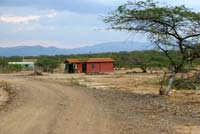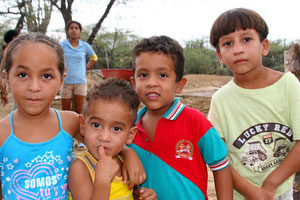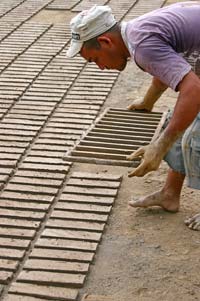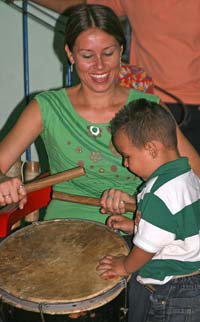Insights from a cultural immersion program in Venezuela
by Jim Hendrickson, Lynden, WA
In April ’08 I joined a group of 19 Americans and six Canadians on a cultural-immersion program to Venezuela offered by Global Awareness Through Experience, or GATE (La Crosse, WI; 608/791-5283, www.gate-travel.org), a nonprofit organization. I had previously traveled with GATE in Guatemala (Nov. ’06, pg. 6) and gained profound insights into the cultural and political situation there.
On this trip I wanted to personally experience life in today’s Venezuela, especially after having been exposed to considerable hostility in the American media toward the Chávez-led government. I hoped to understand Venezuelans as they are, rather than from an us-versus-them perspective.
So it was that I left my home with an open mind and an optimistic spirit in search of reality at a grassroots level. I was to be richly rewarded for my efforts.
An introduction
I met my fellow delegation members in Caracas at Hotel Ávila, a large, Spanish-style inn that lies in a quiet, park-like setting at the base of a mountain range. There we also met our group leaders: Marie Des Jarlais, Violeta Abitia and Lisa Sullivan. Fortunately, all three women spoke English and Spanish fluently, kindly serving as excellent interpreters during the entire trip.
We got an overview of important past and recent events from Charlie Hardy, who spoke from his perspective as a former Catholic missionary working in the barrios of Caracas. He talked of the repression under former dictatorships and the people’s hope for a better life as part of the current socialistic revolution begun by President Chávez.
In the evening, Eva Golinger spoke passionately and at great length about the controversial issue of U.S. intervention in Venezuela. Her talk not only generated many questions from our group, it fostered much discussion among its members.
The following day we conversed with Sister Jenny Russian, who works in Caracas’ Barrio Carapita. This enthusiastic Catholic nun provided an overview of the human rights situation in her community. She seemed content with the progress she had seen thus far: plentiful food, better educational opportunities, more jobs and improved medical care.
After listening to the ideas and opinions of Charlie, Eva and Sister Jenny, I wanted to witness for myself some concrete examples of socialism in action in Venezuela and to ask local residents about their impressions of the Chávez government.
An honest look at Venezuela
My wishes were soon fulfilled when our delegation traveled eastward by minibus to the town of Higuerote, where we stayed at Hotel Barlovento, a beautiful resort set on a beach bordering the Atlantic Ocean. We all took advantage of the sprawling outdoor swimming pool with its luscious, sun-heated water.
Together we visited La Ceiba cacao plantation in nearby San José. Javier, the owner’s son, gave us a fascinating tour of the plantation and spoke of the efforts of his government to encourage small farms and cooperative production. Afterward, we toured a community cooperative for refining cacao before it’s processed into chocolate. Everyone with whom we spoke answered all our questions with gusto.
In addition to these interesting visits and discussions, there was time for relaxation. Five highly talented young men entertained us with traditional music of their region. We also enjoyed a marvelous boat ride among the mangroves in the Tacarigua Lagoon, where we saw hundreds of bright red birds returning to their nests as the sun set gracefully.
From Higuerote, we traveled westward for 12 hours to the city of Barquisimeto.
Village visits
The following morning we rode to the small town of Sanare, where we stayed three nights at Posada El Cerrito, which served as our base.
In the nearby town of Quibor, we toured one of the “university villages” attended by hundreds of deprived students who, for the first time, were able to study foreign languages, law and medicine.
In Carora, the assistant mayor spoke eloquently about the hundreds of community councils that are being created throughout Venezuela. Afterward, he accompanied us to one of them, San Félix, a remote desert village whose residents raise goats and manufacture mud bricks fired in makeshift ovens. I sensed strong feelings of empowerment, accomplishment and dignity among the kind people there.
In the village of Palo Verde we met community, religious and education leaders, then joined them for a dinner of traditional sancocho, a stew consisting of goat meat, potatoes, yucca, plantains and corn. Afterward, a large group of resident children entertained us with traditional music from their region.
After returning to Caracas, we met with a student who expressed his opposition to the Chávez government. We listened intensely to his opinions and asked him many questions.
Meanwhile, hundreds of thousands of Venezuelans assembled in the downtown streets. Most of them wore bright red shirts as a symbol of their solidarity with the socialist revolution. Our group meandered through the enthusiastic crowd toward a raised platform where President Chávez was speaking passionately to the people. It was an impressive sight.
Wrapping up
Our group spent our last night in Venezuela at Posada del Hidalgo in the town of Macuto, located near the international airport. Together we enjoyed an excellent farewell dinner and traded stories about our journey through a country experiencing tremendous change.
The land cost for this fascinating 10-day exploratory trip was $1,700, which covered all program costs in Venezuela except for one meal and taxi fare to the airport. I also paid $300 for the single supplement.
On this trip I experienced a new way of understanding Venezuela by meeting Venezuelans of all ages. I listened to these folks speaking of their past struggles, their current accomplishments and their hopes for a better life for themselves and their children.
In no sense was this a typical tour of Venezuela, as we visited few tourist sites and there was little time for shopping and other leisure activities. However, for me, the many cultural and political exchanges between our Venezuelan neighbors and us proved highly educational.





